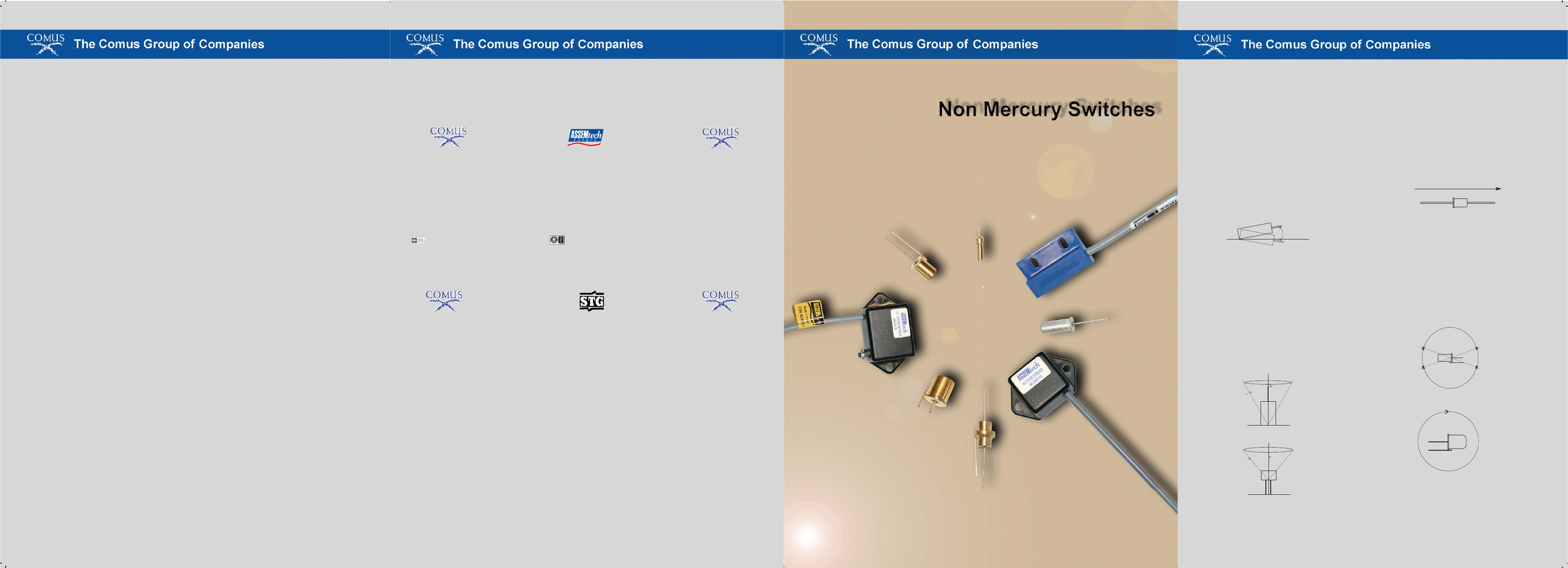
All dimensions are nominal, in millimetres unless otherwise stated. If further information is required, individual datasheets are available on our websites, and on CD.
As part of the group’s policy of continued product improvement, specifications may change without notice. Our sales office will be pleased to help you with the latest information on our products.
Movement and Vibration Switches
When correctly positioned the switch contacts will react by giving an intermittent change
of state when subjected to movement or vibration.
DESCRIPTION
The products included in this catalogue are all designed to detect motion or movement. Forms of movement are: Tilt, Rotation, Vibration, Shock or Acceleration.
Many of these can also be supplied for surface mount applications.
Tilt Switches
These operate when tilted from the horizontal position. The switch movement required to cause
contact change is called the differential angle. It is very important when designing a tilt switch
to allow for the differential angle and understand that when in the horizontal position the
switch contact may be open or closed.
All dimensions are nominal, in millimetres unless otherwise stated. If further information is required, individual datasheets are available on our websites, and on CD.
As part of the group’s policy of continued product improvement, specifications may change without notice. Our sales office will be pleased to help you with the latest information on our products.
Tilt Switch Modules
A Tilt Switch can be located inside a sealed (usually plastic) enclosure. Flying leads are
provided for easy connection.
Tip-Over Switches
These operate when the switch is tilted from the vertical position. The angle through which
the switch has to move before operating is called the operating angle. Many of these
switches are omni-directional. Please state whether you require normally open or closed when
ordering.
Tip-Over Switch Modules
A Tip-Over Switch can be located inside a sealed (usually plastic) enclosure. Flying leads are
provided for easy connection.
Acceleration Sensors
These switches can have a normally open, or normally closed contact which will open
or close when the switch reaches the acceleration activation level.
Movement and Vibration Switch Modules
A Movement or Vibration switch can be located in a sealed (usually plastic) housing.
Horizontal
Contact open
Contact Closed
Differential Angle
Contact closed
Contact open
Contact open
Operate
angle
Horizontal
Contact open
Contact closed
Contact closed
Operate
angle
Horizontal
Direction of acceleration to
close contacts
Centre pin up
contact open
Centre pin down
contact closed
Sensitive
position
Sensitive
position
Position Sensitive
Non Position Sensitive
Switch mounted in any position.
**Movement / Vibration Modules
Due to the unique features of these modules and the wide range of motion and vibration they may be subjected to, we suggest actual testing of these particular models to
determine the suitability of the module for each application.
MS24A/30
This non-mercury sensor has been designed to detect movement or vibration. The sensor will react
when disturbed by giving an intermittent change of state (ie n/o to n/c or vice versa).
The time taken to settle depends on the amount of energy absorbed by the sensor; the settled
state will normally be closed. The sensors contacts, when undisturbed, are normally closed,
however it is possible to mount the switch with contacts open therefore we recommend that appli-
cations look for change of state not contact open or closed. This product offers additional sensi-
tivity adjustment via an internal potentiometer. The output is referenced to 0V and can drive a
transistor or similar device.
MS24P/10
This non-mercury sensor has been designed to detect movement or vibration. The sensor will
react when disturbed by giving an intermittent change of state (ie n/o to n/c or vice versa).
The time taken to settle depends on the amount of energy absorbed by the sensor; the
settled state will normally be closed. The sensors contacts, when undisturbed, are normally closed,
however it is possible to mount the switch with contacts open therefore we recommend that
applications look for change of state not contact open or closed.
CW60A/30
This sealed tilt sensor has a differential angle of 15° Degrees. The output signals are logic
levels with a degree of de-bouncing applied.
The amount of debounce is adjustable via a potentiometer. The output signal can be used to
drive a transistor if required.
The Comus International group of companies consists of:
Comus International
454 Allwood Road
Clifton
New Jersey 07012
U.S.A
Tel: (1)973 - 777 - 6900
Fax:(1)973 - 777 - 8405
email: info@comus-intl.com
Website: http://www.comus-intl.com
Assemtech Europe Limited
Unit 7, Rice Bridge Industrial Estate
Thorpe - Le - Soken
Essex
England
CO16 0HL
Tel: +44 (0)1255 862236
Fax: +44 (0)1255 862014
email: sales@assemtech.co.uk
Website: http://www.assemtech.co.uk
Comus Belgium BVBA
Overhaamlaan 40
B-3700 Tongeren
Belgium
Tel: +32 (0)12 390400
Fax: +32 (0)12 235754
email: info@comus.be
Website: http://www.comus.be
Comus International SARL
Immeuble ‘Les Juilliottes
31 Cours des Juilliottes
F-94700 Maisons-Alfort
France
Tel: +33 (0)1 43 96 86 10
Fax: +33 (0)1 43 96 86 11
email: info@comus.fr
Website: http://www.comus.fr
Switching Technologies Gunther
B-9, B-10, & C-1 Special Economic Zone (MEPZ)
Kadapperi
Tambaram
Chennai 600 045
India
Tel: +91 44 22628093
Fax: +91 44 22628271
email: stg@stg-india.com
We also have a large network of worldwide agents. These can be seen on any of our websites, or on our company profile
brochure.
Com/9/Apr15/Iss.3
Comus Electronics and Technologies
India Private Limited
No 26. Crescent Park Street
T Nagar
Chennai 600 017
India
Tel: +91 44 42127124
Fax: +91 44 42127125
email: syed@comus-intl.com
venkataraman@comus-intl.com
Website: http://www.comusindia.com